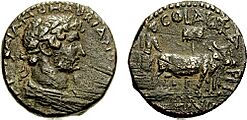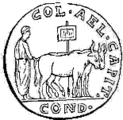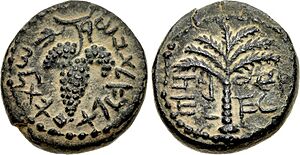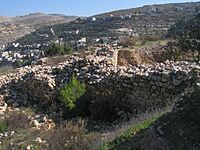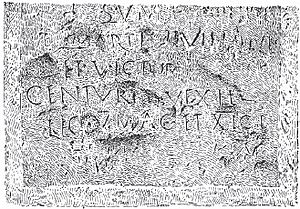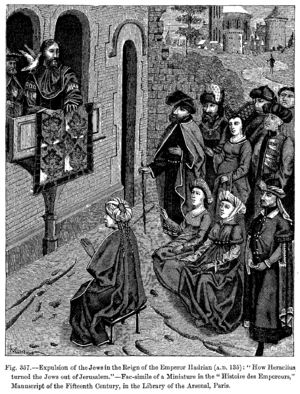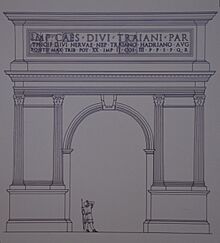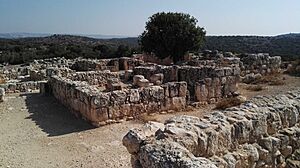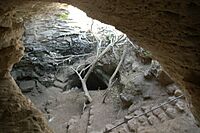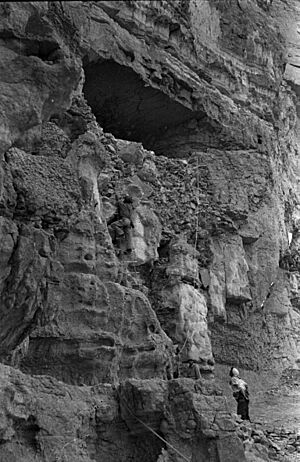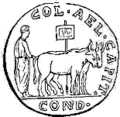Bar Kokhba revolt facts for kids
Quick facts for kids Bar Kokhba revoltמֶרֶד בַּר כּוֹכְבָא |
|||||||||
|---|---|---|---|---|---|---|---|---|---|
| Part of the Jewish–Roman wars | |||||||||
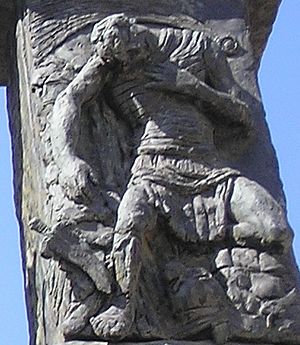 Detail of Simon bar Kokhba from Benno Elkan's Knesset Menorah |
|||||||||
|
|||||||||
| Belligerents | |||||||||
| Roman Empire | Judeans | ||||||||
| Commanders and leaders | |||||||||
|
|
||||||||
| Units involved | |||||||||
|
|
||||||||
| Strength | |||||||||
| 2 legions – 20,000 (132–133) 5 legions – 80,000 (133–134) 6–7 full legions, cohorts of 5–6 more, 30–50 auxiliary units – 120,000 (134–135) |
200,000–400,000 militiamen • 12,000 Bar Kokhba's guard force |
||||||||
| Casualties and losses | |||||||||
| Legio XXII Deiotariana possibly destroyed Legio IX Hispana possibly disbanded Legio X Fretensis sustained heavy casualties |
500,000–600,000 killed | ||||||||
The Bar Kokhba revolt (Hebrew: מֶרֶד בַּר כּוֹכְבָא Mereḏ Bar Kōḵḇāʾ) was a major rebellion by the Jews of Judea. It was led by Simon bar Kokhba against the powerful Roman Empire. The revolt started in 132 CE and lasted until 135 or early 136 CE. It was the third and final big conflict in the Jewish–Roman wars. Sadly, like the earlier wars, the Bar Kokhba revolt ended in a complete defeat for the Jewish people. Simon bar Kokhba himself was killed by Roman soldiers in 135 CE. Any remaining Jewish rebels were either killed or made slaves within the next year.
Life under Roman rule in Judea was very difficult for the Jewish people. This was especially true after the Second Temple was destroyed during the Roman siege of Jerusalem in 70 CE. The Romans kept a large army in the area. They also made unpopular changes to laws and the economy. They built a new city called Aelia Capitolina over the ruins of Jerusalem. Even worse, they put up a temple for their god Jupiter on the Temple Mount. This was the same spot where the Jewish Second Temple had once stood. Many Jewish leaders, like Rabbi Akiva, believed that Quintus Tineius Rufus, the Roman governor, helped cause the revolt. Simon bar Kokhba was a strong and inspiring leader. Many people believed he was the Messiah who would bring back Jewish independence. This belief also helped the uprising spread quickly.
At the start of the conflict, the rebels won some important battles. They created an independent Jewish area that covered much of Judea for several years. Bar Kokhba was named nasi (prince) of this new state. This early success worried the Romans. So, Emperor Hadrian gathered a huge army. It included six full legions and many other soldiers. This massive force, led by Sextus Julius Severus, launched a big military campaign in Judea in 134 CE. They eventually crushed the revolt.
The defeat of Bar Kokhba and his rebels had terrible results for the Jewish people in Judea. It was even worse than the crackdown after the First Jewish–Roman War. Historians believe that between 500,000 and 600,000 Jews were killed. Many others were forced to leave their homes or were sold into slavery. Because of this, Judea became much less populated. After the revolt, the main center of Jewish life moved from Judea to Galilee. The Romans also changed the name of the province from Judaea to Syria Palaestina. This was meant as a punishment for the Jews. The Romans also made new laws that stopped Jews from practicing their religion. They even banned all Jews from entering Jerusalem. The Bar Kokhba revolt also changed Jewish religious ideas. The belief in the Messiah became more spiritual. Jewish religious leaders became very careful and cautious in their political thinking. This rebellion also helped to separate Early Christianity from Judaism.
Contents
Why the Revolt Started
After the First Jewish–Roman War (66–73 CE), Roman leaders tried to control the rebellious province of Roman Judea. They placed a Roman governor and a whole legion, the Tenth Legion, in the area. Tensions grew even more after the Kitos War (115–117 CE). This was another large Jewish uprising in the Eastern Mediterranean. The end of this war saw some fighting in Judea.
Historians believe several things caused the Bar Kokhba revolt. These include changes in Roman law and the presence of many Roman citizens. There were also changes in farming, with people becoming sharecroppers instead of landowners. A possible economic downturn and a rise in Jewish nationalism also played a part. Similar revolts among Jewish communities in other areas had also happened.
The main reasons for the revolt seem to be the building of a new city, Aelia Capitolina, over the ruins of Jerusalem. Also, a temple to Jupiter was built on the Temple Mount. For a while, some historians wondered if Aelia Capitolina was built after the revolt as a punishment. But in 2014, archaeologists found a Roman inscription in Jerusalem. It was from 129/130 CE and mentioned Emperor Hadrian. This, along with coins from Aelia Capitolina, confirmed that the city was built before the revolt.
One idea is that Emperor Hadrian visited Jerusalem in 130 CE. He saw the ruins of the Jewish Temple. At first, he seemed to support the Jews and promised to rebuild the Temple. But the Jews felt betrayed when they learned he planned to build a temple for Jupiter there instead. This made many Jews very angry.
An extra legion, the Sixth Legion, was sent to Judea to keep order. Work on Aelia Capitolina began in 131 CE. The Roman governor, Tineius Rufus, started the building by plowing over the city limits. This act, called "plowing up the Temple," was seen as a serious religious offense by many Jews. It turned them against the Roman authorities.
The Fight for Freedom
Jewish leaders carefully planned this second revolt. They wanted to avoid the mistakes made in the First Jewish–Roman War sixty years earlier. In 132 CE, the revolt began. It was led by Simon bar Kokhba and Elasar. The rebellion quickly spread from Modi'in across the country. It even cut off the Roman army in Jerusalem.
When the Roman Legions X and VI could not stop the rebels, more soldiers were sent. Gaius Poblicius Marcellus came from Roman Syria with Legio III Gallica. Titus Haterius Nepos came from Roman Arabia with Legio III Cyrenaica. Some historians believe that Legio XXII Deiotariana was also sent. But it might have been attacked and destroyed on its way to Jerusalem.
Jewish sources say that Bar Kokhba had about 400,000 men at the peak of the rebellion.

Simon bar Kokhba took the title Nasi Israel (Prince of Israel). He ruled over a Jewish state that was almost independent for over two and a half years. The wise Jewish leader Rabbi Akiva believed Simon Bar Koziba was the Jewish messiah. He gave him the name bar Kokhba, meaning "Son of a Star." This name came from a prophecy in the Bible (Numbers 24:17).
Hidden Tunnels and Caves
As the Roman army slowly advanced, it cut off rebel supplies. The rebels used a clever defense system. They built many underground hiding places in almost every town and village. Many houses had secret hideouts. Rebels hoped to fight the Romans in these narrow passages. The cave systems were often connected. They were used for hiding, storing supplies, and protecting families. These hideouts were found in the Judean hills, the Judean desert, and other areas. By 2015, about 350 hiding systems were found in 140 Jewish villages.
After facing many problems, Hadrian called his general Sextus Julius Severus from Britain. More troops came from far away places like the Danube River. In 133/4 CE, Severus arrived in Judea with three legions from Europe. He also brought soldiers from other legions and many auxiliary units.
The Roman army gathered against the rebels was huge. It was much larger than the army Titus had sixty years earlier. Nearly one-third of the entire Roman army fought against Bar Kokhba. It is thought that forces from at least 10 legions took part. This included the Tenth Legion, Sixth Legion, and others. The total force was between 60,000 and 120,000 Roman soldiers. They faced Bar Kokhba's rebels. Some historians believe the Ninth Legion was destroyed during this war.
After losing many strongholds, Bar Kokhba and his remaining army went to the fortress of Betar. The Romans then surrounded Betar in the summer of 135 CE. The Fifth and Eleventh Legions helped in the siege. Jewish tradition says the fortress was broken into and destroyed on Tisha B'av. This is a day of sadness for the destruction of the First and Second Jewish Temples. Jewish writings say that Bar Kokhba killed his uncle, Rabbi Elazar Hamudaʻi. He suspected him of helping the enemy. This act, they believed, caused them to lose God's protection. The scene after the city was captured was a terrible massacre. The Jerusalem Talmud says that a huge number of people died in Betar.
After Betar fell, the Roman forces went on a rampage. They systematically killed people and destroyed all remaining Jewish villages. They also searched for refugees. The Third Cyrenaica Legion was a main force in this final stage. Historians disagree on how long this Roman campaign lasted. Some say resistance ended quickly. Others argue that small groups of Jewish rebels hid until late 135 or even early 136 CE. But by early 136 CE, the revolt was clearly defeated.
What Happened After
Destruction and Loss of Life
The Bar Kokhba Revolt had terrible results for the Jewish people in Judea. There was a huge loss of life, many people were forced to leave their homes, and many were made slaves. The suffering was even worse than after the First Jewish–Roman War. Central Judea was left desolate. Some scholars even call these events a form of genocide.
A Roman historian named Cassius Dio (who lived from about 155–235 CE) wrote about the aftermath:
50 of their most important outposts and 985 of their most famous villages were razed to the ground. 580,000 men were slain in the various raids and battles, and the number of those that perished by famine, disease and fire was past finding out, Thus nearly the whole of Judaea was made desolate."
While some scholars think these numbers might be too high, they still show the huge disaster for Judea's Jewish population. Archaeological findings confirm that many villages in Judea were destroyed during the revolt. Most Roman-era settlements show signs of destruction or being abandoned. It seems that Jewish settlement in Judea was almost completely wiped out by the end of the revolt.
One estimate suggests that about two-thirds of the Jewish population of Judea died during the revolt. Recent studies in 2021 support Cassius Dio's numbers. They describe his account as "reliable."
Forced Relocation and Slavery
Jewish survivors faced harsh punishments from the Romans. Jews were forced to leave Jerusalem and the areas around it. They were also expelled from other districts. Many Jews moved from Judea to coastal cities and Galilee.
Ancient writers like Eusebius and Jerome describe the suffering. They wrote that Jerusalem was given to other nations. The Temple was destroyed. Jews were driven from their country and forced to serve their enemies.
Roman policy after the war also involved taking many prisoners of war and making them slaves. This happened after other Roman wars too. Sources say that Jewish captives were sold into slavery and sent to different parts of the empire. The slave market was full of new slaves. Jerome wrote that "innumerable people" were sold at a marketplace called Terebinthus. He also noted that thousands were sold there. One old text says Hadrian sold Jewish captives "for the price of a daily portion of food for a horse." More than 100,000 captives might have been enslaved. Many others were sent to Egypt and other regions. This greatly increased the Jewish diaspora.
Even though the Jewish presence in Judea greatly decreased, a small number of Jews remained. Galilee became the new religious center for Jews. Some survivors moved to Galilee. Important Jewish texts, like the Mishnah and parts of the Talmud, were written in Galilee during the 2nd to 4th centuries CE. Jewish communities also continued to live in areas like Ein Gedi and the southern Hebron Hills.
After the defeat, Jewish religious leaders tried to stop Jews from leaving Palestine. They even banned emigration from Palestine.
Religious and Cultural Suppression
After the revolt was put down, Hadrian made new laws to stop Jewish nationalism in Judea. He banned Torah law and the Hebrew calendar. He also had Jewish scholars executed. Sacred Jewish scrolls were publicly burned at the large Temple complex for Jupiter that he built on the Temple Mount. In this temple, he placed statues of Jupiter and himself. These harsh rules stayed in place until Hadrian died in 138 CE. His death brought great relief to the surviving Jewish communities.
Hadrian's policy after the war also included banning Jews from living in or even visiting Jerusalem. Ancient sources confirm this. Eusebius wrote that Jews were completely stopped from entering the area around Jerusalem. They could not even see their homeland from a distance. So, the city was left without its Jewish people. It was then settled by foreigners. Jerome wrote that Jews were only allowed to visit the city to mourn its ruins. They even had to pay for this privilege. To help the new Roman colony of Aelia Capitolina grow, Jews were forbidden to enter the city. The only exception was on the day of Tisha B'Av.
Another lasting punishment was also put in place. To try and erase any memory of Judea or Ancient Israel, the name Judaea was removed from the province's name. Provincia Iudaea was renamed Syria Palaestina.
After Hadrian's death in 138 CE, the Romans eased some of their harsh rules. But the ban on Jews entering Jerusalem remained. Hadrian wanted to get rid of a nation that had caused so much trouble for the Roman Empire.
Roman Losses
The Romans also suffered heavy losses in the war. The Roman army disbanded the Twenty-Second Legion after the revolt. This was possibly because of serious losses. Cassius Dio wrote that "Many Romans, moreover, perished in this war." He also noted that Hadrian did not use the usual opening phrase in his letter to the Senate: "If you and your children are in health, it is well; I and the army are in health." This suggests the losses were very high.
Some historians believe that the large number of Roman veteran diplomas from the 150s and 160s CE shows that many new soldiers were recruited. This was to replace the heavy losses in the legions and auxiliary units between 133 and 135 CE. This period matches the time of the revolt.
As mentioned, the Twenty-Second Legion might have been disbanded after heavy losses. Also, some historians think the Ninth Legion might have been destroyed during this war. The Tenth Legion also suffered many casualties.
Archaeology and Discoveries
Destroyed Jewish Villages and Fortresses
Archaeologists have found many ruins of Roman-era Jewish villages in Judea and Samaria. Most villages in the larger Judea region show signs of destruction or being abandoned around the time of the Bar Kokhba revolt. Buildings and underground tunnels, like hiding places, burial caves, and storage areas, all show signs of destruction. There is also a gap in settlement above these layers.
Excavations at sites like Hurvat Itri and Khirbet Badd ‘Isa show that these Jewish villages were destroyed in the revolt. They were only resettled by other groups much later. Discoveries from towns like Gophna, which was Jewish before the revolt, show that non-Jewish people lived there during the Late Roman period.
The ruins of Betar, Bar Kokhba's last stronghold, are found at Khirbet al-Yahud. This is an archaeological site near Battir and Beitar Illit. A stone inscription found nearby shows that the Fifth Macedonian Legion and the Eleventh Claudian Legion took part in the siege.
Underground Refuges
There were three types of underground refuges: man-made hiding complexes with living spaces and tunnels, cliff shelters carved into steep rock faces, and natural caves.
Hiding Complexes
The discovery of these man-made hiding complexes has helped us understand the Bar Kokhba revolt better. They were found under many sites in Judea and some in the Lower Galilee. Their discovery matches what Cassius Dio wrote. He said the rebels used underground networks to avoid direct fights with the Romans. Many of these tunnels were built earlier. Rebels used them during the revolt, as shown by the coins and other findings.
Hiding complexes were found at over 130 archaeological sites in Judea. Most were in the Judaean Lowlands. Examples include Hurvat Midras, Tel Goded, and Maresha.
Cliff Shelters and Natural Caves
Near the end of the uprising, many Jews fled to refuge caves to save their lives. Most of these caves are in Israel's Judaean Desert. They are on high cliffs overlooking the Dead Sea and the Jordan Valley. Most are large natural caves with few changes made by humans. They are often hard to reach.
People carried valuable items, money, weapons, and even keys to their homes. They hoped to return after the fighting. These items were often found with human bones in the caves. This shows their sad fate. The Cave of Letters in Nahal Hever and the caves in Wadi Murabba'at are well-known. They contained many written records from the time of the revolt.
The Cave of Letters was explored in 1960–1961. Letters and pieces of papyrus were found there. They date back to the Bar Kokhba revolt.
Cave of Horror is the name given to Cave 8. The skeletons of 40 Jewish refugees were found there. They included men, women, and children. Three pieces of pottery with the names of three of the dead were also found.
In 2023, archaeologists found four Roman swords and a pilum (a type of spear). They were hidden in a cave in the Ein Gedi nature reserve. The types of swords and a Bar Kokhba revolt coin found in the cave suggest that Jewish rebels hid these items. They did this to avoid them being found by Roman authorities.
Coinage
As of 2023, twenty-four coins from the Bar Kokhba revolt have been found outside Judea. They were found in different parts of Europe. These include areas that were then Roman provinces like Britain, Pannonia, Dacia, and Dalmatia. Most of the coins were found near Roman military sites. This suggests that Roman soldiers who fought in the uprising might have taken the coins as souvenirs. Or, Jewish captives, slaves, or immigrants might have brought them to these areas after the revolt.
Hoards
Jewish writings describe a common archaeological finding: hoards of Bar Kokhba coins hidden all over Judea. The Jews who hid these coins could not get them back. This was because Roman soldiers were present, or because they were killed during the revolt. It is likely that the widespread destruction also caused these hiding places to be lost. Thirty hoards from this time have been found. This is more than from any other decade.
Geographic Extent of the Revolt
Historians have different ideas about how far the revolt spread. Some, called maximalists, believe it covered all of Judea and even beyond. Others, called minimalists, think it was limited to the Judean hills and nearby areas.
Judea Proper
It is generally agreed that the Bar Kokhba revolt covered all of Judea. This includes the villages of the Judean hills, the Judean desert, and northern parts of the Negev desert. It is not known if the revolt spread outside of Judea.
Jerusalem
Until 1951, Bar Kokhba Revolt coinage was the only archaeological proof for dating the revolt. These coins mention "Year One of the redemption of Israel" and "For the freedom of Jerusalem." Despite the mention of Jerusalem, archaeological finds and the lack of revolt coins in Jerusalem suggested that the rebels did not capture the city.
In 2020, the fourth Bar Kokhba coin with the word "Jerusalem" was found in Jerusalem's Old City. But the Israel Antiquities Authority still believes Jerusalem was not taken by the rebels. This is because thousands of Bar Kokhba coins have been found outside Jerusalem, but only four inside the city. Archaeologists think a Roman soldier might have found the coin during a battle and brought it to Jerusalem as a souvenir.
Galilee
Rebel hideout systems have been found in the Galilee. They are similar to the Bar Kokhba hideouts in Judea. They are fewer in number but still important. The fact that Galilee remained Jewish after the revolt suggests that either Galilee did not join the revolt, or the rebellion there was crushed early.
Samaria
A 2015 archaeological survey in Samaria found about 40 hideout cave systems from the period. Some contained Bar Kokhba coins. This suggests that the war was intense in Samaria.
Legacy
In Rabbinic Judaism
The terrible end of the revolt caused big changes in Jewish religious thought. Jewish messianism became more spiritual. Jewish religious leaders became very careful and cautious in their political ideas. The Talmud, for example, calls Bar Kokhba "Ben-Kusiba," which means "Son of Deception." This shows he was seen as a false Messiah.
Eusebius wrote that Christians were killed and suffered "all kinds of persecutions" from the Jewish rebels. This happened when they refused to help Bar Kokhba fight the Romans. Even though Christians believed Jesus was the Messiah and did not support Bar Kokhba, they were banned from Jerusalem along with the Jews.
The rebellion helped to create a clear separation between early Christianity and Judaism.
In Zionism and Modern Israel
After the time of the rabbis, the Bar Kokhba Revolt became a symbol of brave national resistance. The Zionist youth movement Betar took its name from Bar Kokhba's last stronghold. David Ben-Gurion, Israel's first prime minister, took his Hebrew last name from one of Bar Kokhba's generals.
A popular children's song in Israeli kindergartens has the line "Bar Kokhba was a Hero/He fought for Liberty." The song tells a story of Bar Kokhba being captured and thrown into a lion's den, but escaping by riding on the lion's back.
See also
- History of the Jews in the Roman Empire
- Jewish–Roman wars
- First Jewish–Roman War, 66–73 CE
- Kitos War, 115–117 CE
- Jewish revolt against Constantius Gallus, 352 CE
- Samaritan revolts, 484–572 CE
- Jewish revolt against Heraclius, 614-617/625
Images for kids


